Crop Protection
Sealer cum Healer for Mango Trunk Borer management
- A powder formulation used in treating the plant for borer
- Complete relief from borer problem
- Blocks the unseen holes and as well visually seen holes,
- Rejuvenates the tree with nutrition
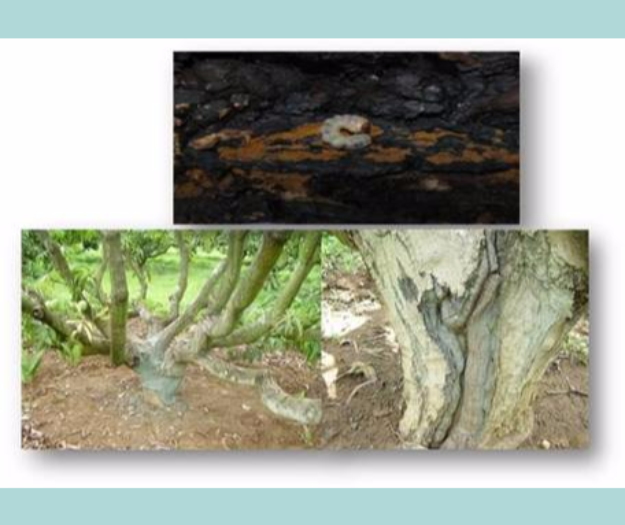
Seedpro( A microbial growth promoter & fungal Disease Suppressor)
- An immobilized product of Bacillus subtilis and Hypocrea lixi
- Efficacy of Seedpro tested on wide range of vegetable crops like brinjal, beans, cabbage, chilli, tomato etc., oil seed crop such as soya bean & fruit crops like papaya for growth promoting activities.
- Seedpro has effectively enhanced root length, shoot length, leaf area, seedling vigour & seedling biomass from 28.6% to 92.85%.
- Used for successful production of quality & disease free vegetable seedlings and Reduction of seed and soil fungal diseases.
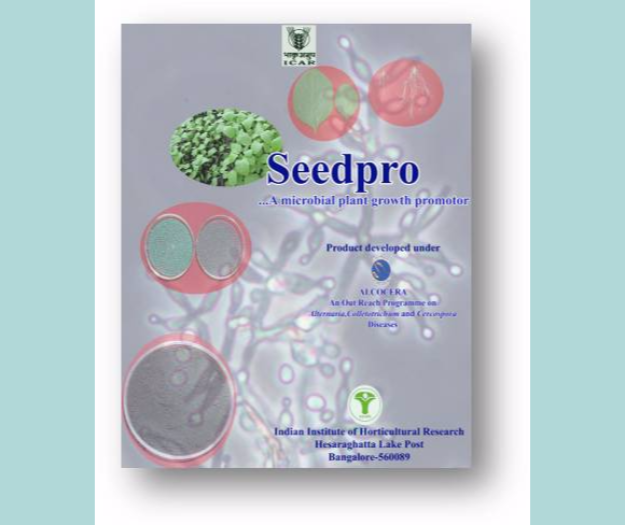
Trichocard - Trichogramma Technology
- Eco-friendly Management of Brinjal Shoot & Fruit Borer (Leucinodes orbonalis )
- Trichogramma parasitizes the eggs, thus killing lepidopterous pests before they could inflict damage on the host plant
- Each ‘trichocard’ contains 20,000 trichogramma parasitized eggs.
- A single Trichogramma while multiplying itself can kill over 100 eggs of the pests
- Periodical release of Trichogramma results in killing the pest even before they are born.
- The parasite searches and kills the host eggs which are otherwise inaccessible to conventional insecticidal sprays.
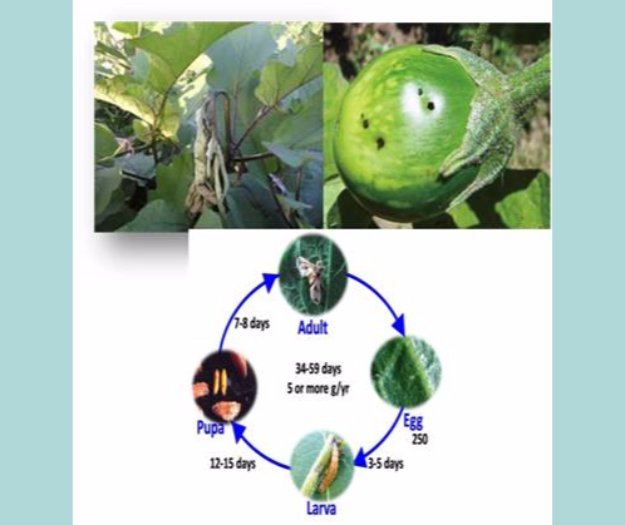
Microbial Biocontrol Agents
- Trichoderma harzianum
- Pseudomonas fluorescens
- Trichoderma viridae
- Paecilomyces lilacinus
- Pochonia chlamydosporia
- Can be a component of IPM, Biopesticides can decrease the use of chemical pesticides
- Increase the yield of the crop & lead to sustainable productivity in a long run
- They have specific mode of action on pathogens.
- Helps in developing disease suppressive soils.
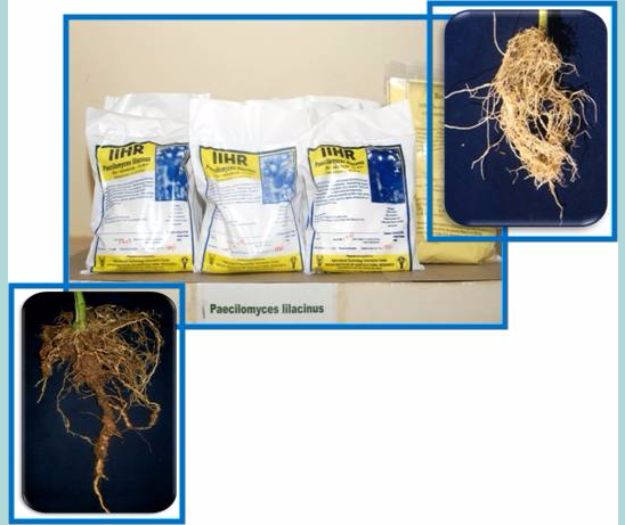
Pseudomonas fluorescens
- Bio- pesticide containing IIHR isolate no. (IIHR Pf -2) of Bio-control of bacteria.
- The bio-agents effectively control Root-Knot nematodes (Meloidogyne Sp. Ralstonia solanacerum, Erwinia caratovora, Fusarium sp. & Rotylenchus reniformis) on capsicum, onion,cabbage,cauliflower,crossandra,roses, gerbera,banana,grapes,guava, acid lime, papaya, tomato, egg plant and transplanted crops.
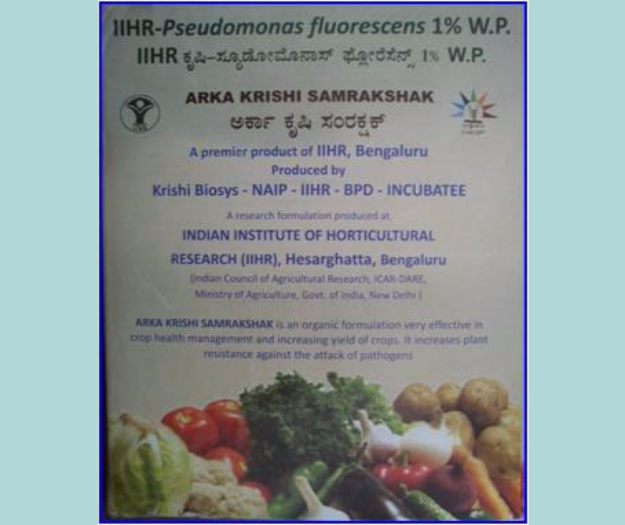
Trichoderma viridae
- This is a Bio- pesticide containing IIHR isolate no. (IIHR Tv-5) of Bio-control of fungi
- The bio-agents effectively controls Root-Knot nematode (Meloidogyne Sp.) phytophthora, Fusarium. Oxysporum.,Sp & Rotylenchus reniformis on all horticultural crops.
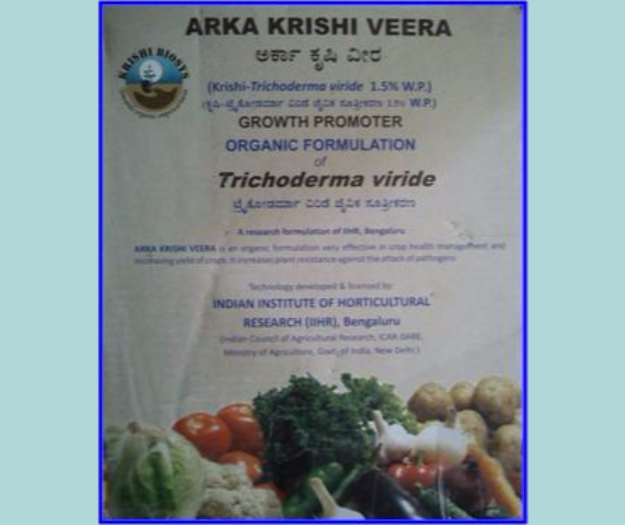
Trichoderma harzianum
- This is a Bio- pesticide containing IIHR isolate no. (IIHR Th-2) of Bio-control of fungi
- The bio-agents effectively control Root-Knot nematode (Meloidogyne Sp.) Phytophthora, Fusarium. Oxysporum.,Sp & Rotylenchus reniformis, Sclerotium on capsicum,onion,cabbage,cauliflower, crossandra, roses, gerbera, banana, Grapes, Guava, acid lime, papaya, tomato, egg plant and transplanted crops.
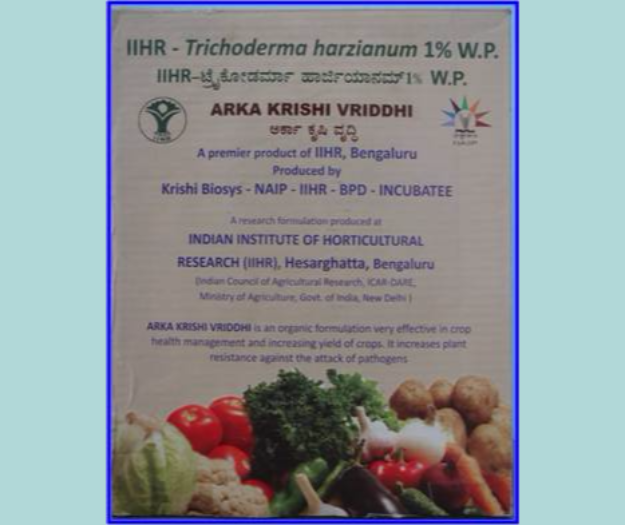
Paecilomyces lilacinus
- This is a Bio- pesticide containing IIHR isolate no. (IIHR PI-2) of nematophagus fungus.
- The bio-agents effectively control Root-Knot nematode (Meloidogyne Sp.) and Tylenchulus semipentrans (Citrus Nematode) on all horticultural crops
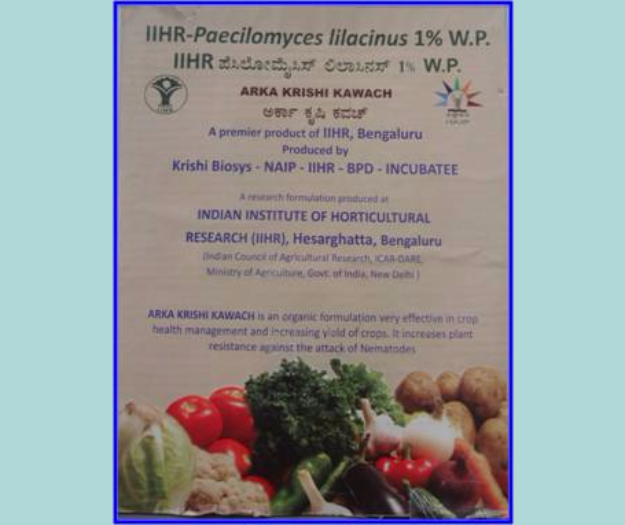
Pochonia chlamydosporia
- This is a Bio- pesticide containing IIHR isolate no. (IIHR vc -3) of nematophagus fungus
- The bio-agents effectively control Root-Knot nematode (Meloidogyne Sp.) and Cys Nematodes (Heterodera Sp.) on capsicum, onion, cabbage, cauliflower, crossandra, roses, gerbera,banana,grapes, Guava, acid lime, papaya, tomato, egg plant and transplanted crops.
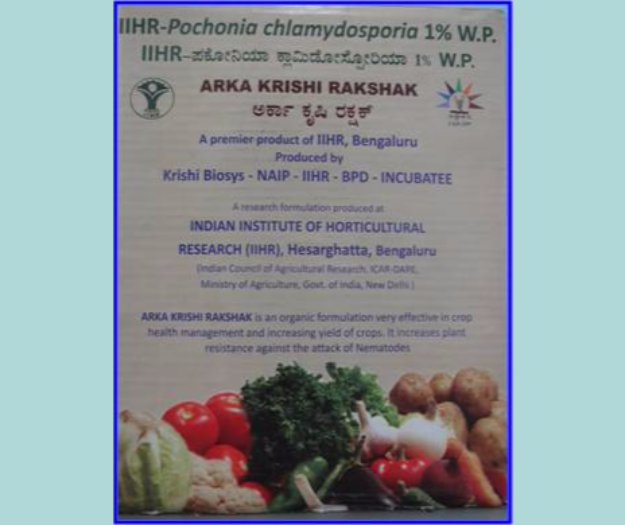
Arka Suraksha - (Bacillus licheniformis IIHR S3b)
- Beneficial rhizobacteria promoting plant growth & yield enhancement (upto 20-30%).
- Talc based formulations of Arka Suraksha used for seed treatment & coir pith amendment
- Enhances seed germination, seedling vigour & crop biomass in vegetable & field crops
- Reduces Alternaria blight infection, i.e purple blotch in onion and early blight in tomato.
- Eco-friendly & suitable for disease management in organically grown onion & tomato
- Micro-organisms used in the formulations are compatible with fungicides used in management of Alternaria blight & powdery mildew
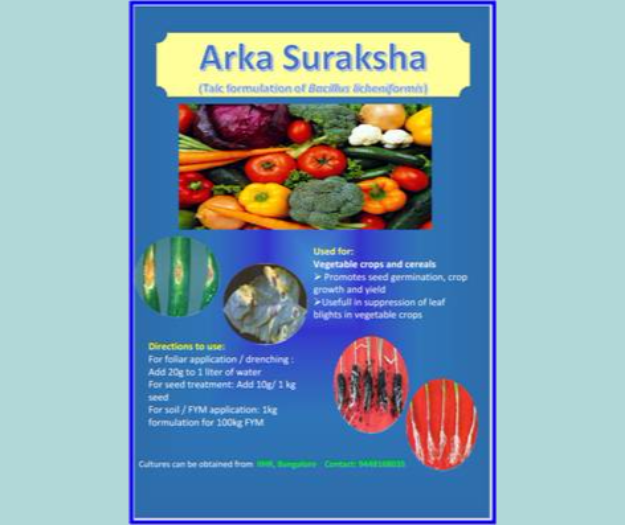
Management of DBM and aphids using neem seed powder formulations (Arka Neem Seed Powder Pellet formulation)
- The main limitation for using neem seed powder is cumbersome and time-consuming process and the resulting extract is highly unstable with a short shelf life. Thus the present talc-based neem seed powder pellets were developed for increased insecticidal efficacy and shelf life in ready-to-use form. Neem seed powder pellet formulation performed well in terms of DBM management with mean DBM count as 0.6, against control (5.33) and it was as good as Neem seed powder extract. In terms of aphids management also Neem seed powder pellet formulation performed well (Aphid count is 0.12 as against control, 4.48) and is on par with NSPE.
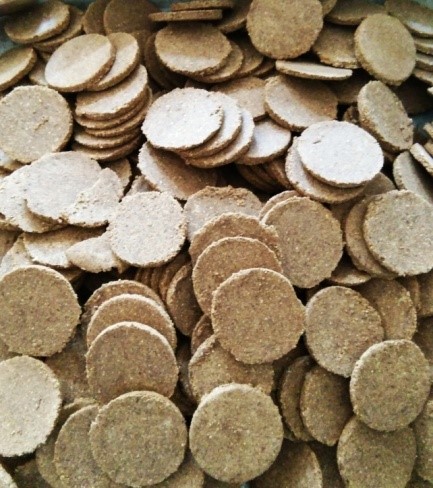
Improved version of Sealer cum Healer for the control of Mango stem borer (Arka Borer control)
- The innovated formulation consists of several inert materials to serve as carrier and herbal oils to be effective for one season without adding any insecticide. This formulation is mixed with water in a ration of 1:0.4 (approx) to bring down to gel form or melted ice cream consistency to be applied on mango stem using 2 or 3 inches brush. The swabbed formulation is allowed to dry on plant so that it works as repellent and as well as curative treatment to neutralize the eggs, early instars of larvae and grubs living on stem. The improved formulation of SCH was significantly superior to control by avoiding infestation up to 8 weeks in laboratory trial. When the trial was continued further for 16 weeks the female beetle spent time up to 3.3 percent of its total time compared to 60.3% of its time in control suggesting its repellency effect up to 4 months. The product swabbed with older formulation and immersed in water for overnight lost nearly 52% of swabbed SCH but in new formulation the loss on solubility was less than 1%. The product is now made suitable for both low and heavy rainfall areas and also oviposition deterrent for mango stem borer Batocera rufomaculata and hence can be applied as an effective prophylactic measure.
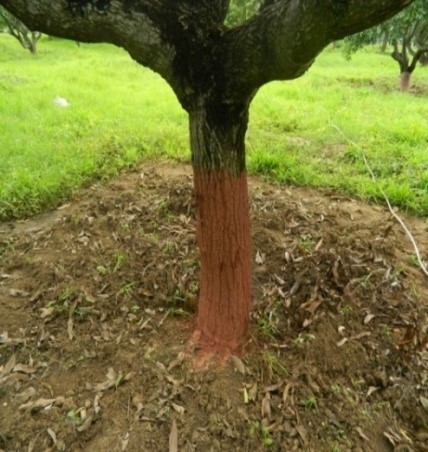
Integrated management of tomato moth, Tuta absoluta on tomato under polyhouse conditions
- Tomato moth, Tuta absoluta (Meyrick) (Lepidoptera: Gelechiidae) is one of the major invasive pests of tomato with a potential to incur 100 % yield losses particularly under tomato grown under polyhouse conditions. The effective package for the control of Tuta consists of use of incandescent bulb @ one bulb/150 m2 + 1 pheromone trap/300 m2 + need based spray of spinosad 0.25 ml/l/flubendiamide @ 0.20 ml/lin rotationat 3 weeks interval. Coinciding with the peak emergence of the Tuta adults, spray of decamethrin 2.5 EC @ 1 ml/l for killing adults. Light traps are to be kept before transplanting of the crop itself. All the materials required are locally available, farmer friendly, economical & ecologically viable. With this package, number of eggs laid by Tuta was also significantly lower in IPM plots when compared to non-IPM plots (up to 30/leaf in IPM plots as against 0-2 eggs/leaf under IPM conditions).
Note (other points to be kept in mind in IPM plots): Light/pheromone traps are to be installed before transplanting of the crop itself for effective pest monitoring and management; remove and destroy the affected plant parts and alternate hosts etc.
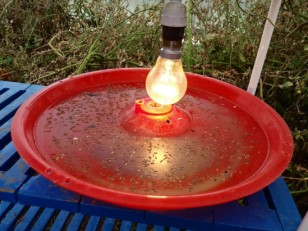
Bio-intensive management of Brinjal fruit and shoot borer.
The technology involves erection of pheromone traps, release of egg parasitoid, Trichograma chilonis @ 50,000/week/ha and two aprays of BT formulations @ 1 ml/l @ 50% flowering (once in 10 days), which reduced the incidence.
Mass rearing of Brinjal shoot and fruit borer (Leucinoides arbonalis Guenee)
Brinjal shoot and fruit borer is a typical holometabolous and monophagus lepidopteran pest. Sufficiently large population of different stages of this insect are needed to undertake screening of Bt transgenic Brinjal plants for challenge inoculation based resistance phenotyping. This technology to produce large number of various stages of this insect.
IIHRS2b and IIHRS3b : Promising bio agents in the management of purple blotch disease of Onion.
Presently purple blotch disease of onion is being managed only by the use of fungicides IIHR S2b and IIHRS3b- are promising bioagents in the management of purple blotch disease of onion New bioagents helps in minimization of usage of fungicides and also in enhance yields
The technology is environmental friendly and helps farmers in minimizing the input cost on fungicides and also on improvisation of yield. Biocontrol agents for the management of foliar diseases
The technology is environmental friendly and helps farmers in minimizing the input cost on fungicides and also on improvisation of yield. Biocontrol agents for the management of foliar diseases
Integrated watermelon bud necrosis disease management in water melon.
Combination of cultural and chemical control measures helps in reduction of vector and virus incidence.
70 to 80 % reduction in vector thrips population in treatments compared to control.
67 to 78% reduction in virus incidence in treatment as compared to Control.
There is 45 to 60% increase in yield by following IDM as compared control (this result based on previous years)
70 to 80 % reduction in vector thrips population in treatments compared to control.
67 to 78% reduction in virus incidence in treatment as compared to Control.
There is 45 to 60% increase in yield by following IDM as compared control (this result based on previous years)
Construct for monoclonal antibodies to detect PBNV.
The antibodies can detect the virus in less than 10 mg of tissue and within one single cell with help of fluorescent microscope. Easy detection helps the farmers to manage his orchard economically , and te researchers are benifited scientifically.
Biological control of Mango inflorescence hoppers Idioscopus sps
This technology is effective. The developed technology is effective, pesticide free; eco-friendly conserves bio- diversity as it is non- toxic to pollinators and other beneficial organisms. The load of chemical pesticides usage could be completely eliminated for management of hopers ed will be drastically reduced.
Arka Suraksha
Bacillus licheniformis, a potential antagonist for the management of purple blotch disease of onion.
Fruit fly trapping technology for mango for Eastern India Region
Plastic traps with soaked wood block containing killing agent have been developed to manage fruit fly in fruit crops. Wood block size – 5 x 5 x 1.2cm, Soaking material – Ethanol + Methyl eugenol (6: 4) for 24 hrs. Killing agent – Malathion/DDVP can be dripped 1-2 drops after installing the trap, Plastic container – 750 ml plastic container with holes (dia – 2.5cm), Rate of traps/ha – 10. Fruit fly incidence is reduced to less than 5%.
Fruit fly trapping technology for cucurbits for Eastern India Region
Plastic traps with soaked wood block containing killing agent have been developed to manage fruit fly in cucurbits. Wood block size – 5 x 5 x1.2cm, Soaking material – Ethanol + Cue lure (6: 4) for 24 hrs. Killing agent – Malathion/DDVP can be dripped 1-2 drops after installing the trap, Plastic container – 750 ml with holes (dia – 2.5cm). Rate of traps/ha – 10. Fruit fly incidence is reduced to less than 5%.
Liquid and talc based formulations of Bacillus subtilis
Developed liquid and talc based formulation of novel biocontrol agent Bacillus subtilis (IIHR BS-2, NAIMCC – B-01211). Highly effective against eggs and juveniles of root knot nematodes (Meloidogyne incognita) infecting horticultural crops with killing efficiency of up to 90.26%. Recorded yield increase of 26.5% in okra, 19.2% in tomato, 22% in banana. Shelf life 18 months; Toxicology data is generated.
Method of mass production of soil-less arbuscular mycorrhizal fungal inoculums
The present technology provides a method for soil-less production of AM fungal inoculum by utilizing sterile Arka Fermented Cocopeat as the sole substrate for host plant growth with the intervention of beneficial bacteria (applied at the rate of 0.5 kg per 1000 kg Arka Fermented Cocopeat substrate). This helps in enhancing the host plant root growth, AM fungal colonization and proliferation within the host plant roots, and to derive an inoculum free of any cross contamination. The entire process can be carried out in a time span of 60 days under ambient conditions either under shade or glass house. A count of 0.28 – 0.35 x105 Infective propagules / gram of substrate was obtained using this method. The shelf life is upto one year.